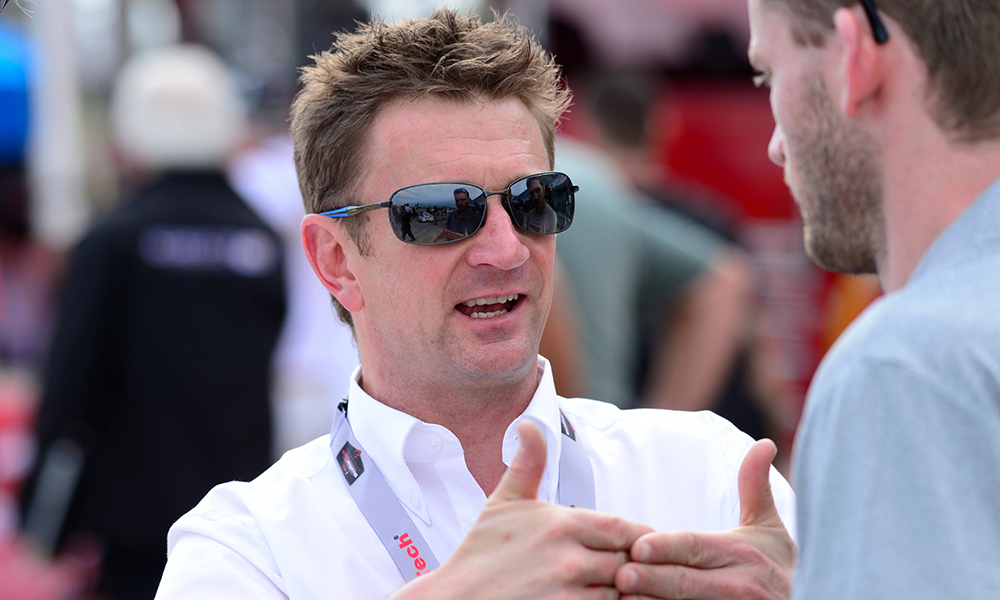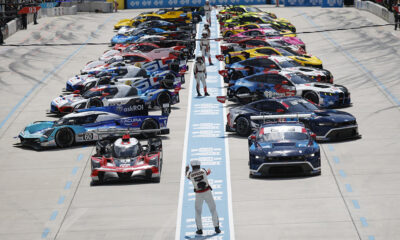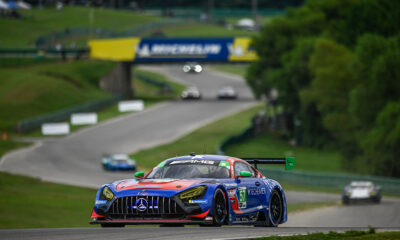
Photo: Rick Dole/IMSA
The 3.74-mile, 17-turn Sebring International Raceway course layout is one of the most challenging and respected anywhere in the world.
Built on the site of the former Hendricks Army Airfield used in World War II, the track uses a combination of former concrete runways – the same concrete from back in the day – and asphalt sections.
It’s memorable enough to remain fresh in the mind of Allan McNish, a four-time Mobil 1 Twelve Hours of Sebring Presented by Advance Auto Parts overall winner and the grand marshal of both the IMSA WeatherTech SportsCar Championship 12-hour event and Friday’s FIA World Endurance Championship 1000 Miles of Sebring.
Here’s the Sebring racetrack according to McNish:
“You could stand at the outside of Turn 1 and just watch a car going through there, and you could see the driver – even in a closed-cockpit car – you could see the driver sweating and having to hang onto it.
“The car’s bucking around underneath you, trying to make sure you don’t have a little bit too much lateral load onto the right rear as you come over the bump from the concrete onto the tarmac at the exit of 1, because that could quite easily spit you into the barrier on the left-hand side.
“Just things like that, you get a real feeling that these cars are going so quick. Like, so, so fast. A small mistake is a huge mistake in terms of the consequences at Sebring. That, I think, made us as drivers treat it with a lot of respect.
“At the same time, the fans could really watch it. When I say fans, I’m talking about us drivers who weren’t qualifying, going and watching out there just to see how much your teammate is giving it one, because you could see it live and it gave such feedback. That’s one very special thing about it.
“There’s not many corners, in all honesty, at Sebring, where you didn’t really have to be on top of your game. I talked about 1, that’s because of the bumps, the fast entry speed and the blind apex and the fact the track narrows up on exit.
“But then you talk about 3, going into 3 at the chicane there. You hit the brakes and you’ve got to watch out, because there’s a little dip on the right-hand side and it’s easy to lock the right-front into there.
“It’s also easy to brake too early, because then you miss your apex and then you lose the front and it washes out and it compromises you in 4 and into 5 and then all the way down into 7.
“At 5, you’ve got to change your line through the race, because it hooks up in a different way from the start of the race to the middle to the end. At 7, again, you’ve got to change your line, and you’ve also got to be careful in the first attack on the braking.
“At 10, you can brake so deep into 10 that you cannot believe when the grip’s there. You’ve got to adapt and understand what you can do and how you can overtake on the inside in 10, as well, which at some points in the race is not so easy.
“Through 11, 12 and into 13, can you overtake into 13 or not? It’s a big risk, so you need to be able to do it in traffic, because you can lose a second out of 13 following a GT car through there. But at the same time, you need to have the front grip to be able to achieve it.
“Then, into 15, floating so much speed into 15 without compromising your run through 16 and onto the back straight. So, every corner itself, before you sort of take the big deep breath and wing around the wall and over the bumps in 17, it requires total focus and concentration. That’s why it’s a really, really cool one. I’ve got memories of every single corner and something that’s gone on at every single corner.”
McNish is convinced that the track layout is one of the key reasons why thousands of race fans return each year, as they will again this week. Tradition is a valuable commodity in motorsports, and Sebring has it in spades.
“From watching videos of Stirling Moss driving around there whenever it was (Moss won in 1954), it hasn’t really changed that much from then either,” he said. “That’s something that gives it a real character. It’s something that I think as well, when you go back, you’ve got a memory of something that you can really attach to.
“I’m sure that’s why the fans come back and they come back every single year in droves. They’ve got their rituals. If you go back a few years, you do build up the relationship with the particular sets of fans.
“The one that most people think of, obviously, is the Turn 10 Club, but those guys, they live and love and breathe it just as much as we do as competitors or drivers or team bosses or whatever it is.
“That gives that race a special, one-off, unique atmosphere that I’ve never found anywhere else.”


























